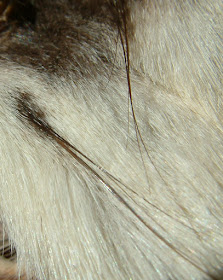During the health check he wore a special hood. Having his eyes covered makes the health check less stressful and helps the island fox remain calm.
M152 was:
Weighed - to compare his weight with previous years and to provide an overall view of the population across the island. How much did M152 weigh?
Blood Sample - A sample of his blood was taken to look for evidence of exposure to disease. In 2016-2017 blood samples documented adenovirus, commonly called "kennel cough," as it moved across Catalina Island infecting 85% of the island fox population. (See 2018 Update) Fortunately, no island fox deaths were attributed to the virus, but it demonstrated how fast an infectious disease can spread through island foxes. Testing blood samples provides an early warning of dangerous diseases like canine distemper, parvo, and more. It can also indicate whether disease might be influencing low pup survival. Some of M152's blood was also set aside to test for specific white blood cells. A high number of these cells may be evidence of a parasite infection. Some of the blood sample will also be used for DNA studies to determine the familial relationships between individual foxes. How are the pups in M152's territory related to him? All of this is above and beyond simple monitoring.
Your donations help make this health research possible.
Disease - M152 showed no signs of disease. He appeared healthy.
 |
| M152 courtesy of Channel Islands National Park |
Tick Testing - M152 was examined for fleas and ticks. Luckily he was tick free! But not all island foxes are so lucky.
 |
| small red dot is a tick on the fox's ear |
Tick-borne disease is a new threat to island foxes. Two infectious diseases carried by ticks have recently been discovered on the Channel Islands: Lyme disease and relapsing fever. Ticks found on island foxes, like the one on the back of an island fox's ear, pictured at right, are being removed and tested for disease. This is important research for island foxes and people.
How many ticks are carrying disease? How many island foxes are infected? Lyme disease seriously impacts dogs; is it impacting island foxes? The tick is removed and tested to see if it is a disease carrier.
 |
| Tick after removal and prepared for testing. |
Tick-borne disease is a new threat.
We need your help to fund testing of ticks.
Removing the tick is also beneficial to the island fox.
 |
| Island fox ear after tick is removed. |
Island foxes need your help.
Friends of the Island Fox funds radio collars,
proactive health testing, and vital research.
With your continued support, we can hold onto success and keep island foxes like M152 healthy into the future.
Please donate today.











































